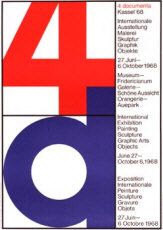Documenta 4
27 Jun - 06 Oct 1968
27 June - 6 October 1968
Kassel
The run-up to documenta 4 in 1968 was riddled with debate and controversy, with the key question being the very future of the documenta. The politicization of society in the late 1960s also made itself felt in Kassel – red flags and groups of people chanting slogans meant that the opening speeches could not be held. Moreover, internally documenta 4 underwent a generational conflict and a debate on the fragile relationship of aesthetic judgment and democratic forms of reaching a consensus . The exhibition's organization was entrusted to a so-called documenta council. At the end of the preparations, the council had 24 members, who were sub-divided into various working committees (e.g., for painting, sculpture, „ambient“, etc.). The difficulty of reaching aesthetic judgments given such committee democracy and administration, as well as the sometimes great skepticism among some of the older members (including, for example, Werner Haftmann) that consensus-based aesthetic judgments were possible at all, often ended in a dead-end. Jean Leering, the young director of the Stedelijk Van Abbemuseum Eindhoven, who was appointed head of the painting committee after the death of two council members, took advantage of the situation and emerged alongside Bode as the decisive figure heading the exhibition.
In deliberate contrast to its precursor, d4 presented itself as the „youngest documenta there ever was“. All forms of retrospective were eschewed, and the exhibition concentrated completely on current art activities in the 1960s, doing full justice to the plethora of forms of artistic expression. d4 conclusively opened itself up for the dominance of American art, which took center stage in terms of space with large-sized works of Post-Painterly Abstraction and color field painting, and also offered a new understanding of our relationship to reality with Minimal Art and Pop Art – revealing Haftmann's hypothesis on „abstraction as a world language“ to be a historical model. The newly-devised section on artists' environments in the Neue Galerie – artistic spaces in which visitors are able to move and, as with Edward Kienholz's „Roxy's“ (1961), a reconstruction of a 1950s US brothel, were compelled to shed any distanced stance– were the focus of attention at the show. The now well-established form of presenting sculptures outside the Orangerie was changed, as the architectonic framing of the works was abandoned and the works placed instead in loose groups on the Karlswiese meadows. Christo's „5,600 Cubic Meter Package“ – 85 meters high and brashly placed in the middle of the meadows– was a landmark for the new understanding of art that no one could miss seeing.
Given the breadth of forms of artistic expression, informed by the widest variety of different conceptions of material and reality and by an increasing focus on theoretical issues, the exhibition organizers realized the crucial problem, namely that viewers' habits of perceiving artworks had not changed over the previous decades. In order to bridge the distance between modern art production and its reception, and no longer leave the viewer out in the cold, documenta 4 for the first time featured a „visitors' school“ led by Bazon Brock, conveying to those attending an understanding for the reception of art as an act of labor in its own right, and explaining new ways of approaching contemporary art.
Artistic Director:
Arnold Bode
Artists:
Josef Albers
Getulio Alviani
Carl Andre
Horst Antes
Richard Anuszkiewicz
Shūsaku Arakawa
Arman
Richard Artschwager
Jo Baer
Larry Bell
Ben Berns
Joseph Beuys
Ronald Bladen
Peter Brüning
Pol Bury
Bazon Brock
Antonio Calderara
Sérgio de Camargo
Anthony Caro
Enrico Castellani
Jorge Castillo
César (César Baldaccini)
Eduardo Chillida
Christo und Jeanne-Claude
Chryssa
Emil Cimiotti
Gianni Colombo
Joseph Cornell
Ron Davis
Ad Dekkers
Hugo Demarco
Burgoyne Diller
Jim Dine
Mark di Suvero Milan Dobeš
Jean Dubuffet
Pieter Engels
John Ernest
Öyvind Fahlström
Dan Flavin
Lucio Fontana
Günter Fruhtrunk
Rupprecht Geiger
Klaus Geldmacher
Karl Gerstner
Domenico Gnoli
Roland Goeschl
Daan van Golden
Gerhard von Graevenitz
Gotthard Graubner
Raymond Hains
Richard Hamilton
Erich Hauser
Erwin Heerich
Al Held
Edward Higgins
Anthony Hill
David Hockney
John Hoyland
Robert Indiana
Alain Jacquet
Alfred Jensen
Jasper Johns
Allen Jones
Donald Judd
Menashe Kadishman
Utz Kampmann
Ellsworth Kelly
Edward Kienholz
Phillip King
Ronald B. Kitaj
Konrad Klapheck
Yves Klein
Jiří Kolář
Gyula Kosice
Nicholas Krushenick
Thomas Lenk
Julio Le Parc
Sol LeWitt
Roy Lichtenstein
Richard Lindner
Richard Paul Lohse
Francesco Lo Savio
Morris Louis
Robert Malaval
Jos Manders
Piero Manzoni
Enzo Mari
Walter De Maria
Francesco Mariotti
Escobar Marisol
Kenneth Martin
Almir Mavignier
Christian Megert
François Morellet
Robert Morris
Bruno Munari
Bruce Nauman
Edgar Negret
Louise Berliawsky Nevelson
Barnett Newman
Kenneth Noland
Lev V. Nussberg
Claes Oldenburg
Jules Olitski
Eduardo Paolozzi
Walter Pichler
Michelangelo Pistoletto
Larry Poons
Markus Raetz
Ramon
Robert Rauschenberg
Roger Raveel
Martial Raysse
Josua Reichert
Ad Reinhardt
George Rickey
Bridget Riley
Larry Rivers
James Rosenquist
Dieter Roth
Lucas Samaras
Michael Sandle
Jan Schoonhoven
George Segal
Dan van Severen
David Smith
Richard Smith
Tony Smith
Robert Stanley
Frank Stella
Zdeněk Sýkora
Shinkichi Tajiri
Vassilakis Takis
Paul Talman
Antoni Tàpies
Hervé Télémaque
Paul Thek
Joe Tilson
Jean Tinguely
Ernest Trova
William Tucker
William Turnbull
Michael Tyzack
Günther Uecker
Per Olof Ultvedt
Victor Vasarely
Carel Visser
Jan Voss
Andy Warhol
Tom Wesselmann
Horace Clifford Westermann

